Connect With Us
Blog
Items filtered by date: July 2025
Ease Painful Feet With Orthotics

Custom orthotics can be used to relieve foot pain and discomfort. They're also used to treat various foot conditions and deformities. Flat feet, bunions, and Morton's neuroma are just a few of the foot conditions that have been known to benefit from the use of orthotics.
Comfy feet are happy feet! Contact us today.
Preventing Falls and Foot Injuries in the Elderly
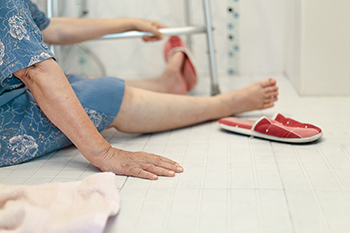
Falling accidents may increase with age, and preventing falls and related foot injuries begins with strengthening exercises to improve leg and foot muscles, enhancing overall stability. Balance training helps maintain coordination and confidence while walking. Using a cane or walker can offer vital support, especially for those with limited mobility. Changing footwear to supportive, non-slip shoes greatly reduces the risk of slipping. It is also important to review medications that may cause dizziness or instability. A podiatrist can evaluate foot health, recommend appropriate devices, and create personalized care plans for seniors to improve balance and prevent falls. If you have endured a foot or ankle injury from falling, it is suggested that you consult a podiatrist who can treat various foot conditions and guide you on effective fall prevention tips.
Preventing falls among the elderly is very important. If you are older and have fallen or fear that you are prone to falling, consult with Josef Elouze, DPM from Elite Podiatry. Our doctor will assess your condition and provide you with quality advice and care.
Every 11 seconds, an elderly American is being treated in an emergency room for a fall related injury. Falls are the leading cause of head and hip injuries for those 65 and older. Due to decreases in strength, balance, senses, and lack of awareness, elderly persons are very susceptible to falling. Thankfully, there are a number of things older persons can do to prevent falls.
How to Prevent Falls
Some effective methods that older persons can do to prevent falls include:
- Enrolling in strength and balance exercise program to increase balance and strength
- Periodically having your sight and hearing checked
- Discuss any medications you have with a doctor to see if it increases the risk of falling
- Clearing the house of falling hazards and installing devices like grab bars and railings
- Utilizing a walker or cane
- Wearing shoes that provide good support and cushioning
- Talking to family members about falling and increasing awareness
Falling can be a traumatic and embarrassing experience for elderly persons; this can make them less willing to leave the house, and less willing to talk to someone about their fears of falling. Doing such things, however, will increase the likelihood of tripping or losing one’s balance. Knowing the causes of falling and how to prevent them is the best way to mitigate the risk of serious injury.
If you have any questions, please feel free to contact our office located in (Holiday City) Toms River, NJ . We offer the newest diagnostic and treatment technologies for all your foot care needs.
Managing Swelling in the Legs and Ankles
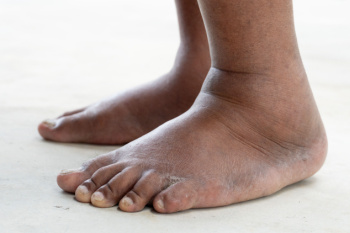
Leg and ankle swelling, also known as edema, can result from a variety of causes, including circulation problems, injury, prolonged sitting, or underlying health conditions. It may feel tight, heavy, or uncomfortable, and the skin can appear stretched or shiny. Simple steps like elevating the legs, wearing compression socks, and reducing salt intake can sometimes bring relief. However, persistent or worsening swelling may signal something more serious. Conditions such as vein disease, heart issues, or lymphatic problems can all contribute to fluid buildup in the lower limbs. Because untreated edema can lead to skin damage, discomfort, or infection, ongoing swelling should never be ignored. If you notice puffiness that does not improve or comes with other symptoms, it is suggested that you see a podiatrist for an in-depth evaluation and the right course of treatment.
Swollen feet can be a sign of an underlying condition. If you have any concerns, contact Josef Elouze, DPM of Elite Podiatry. Our doctor can provide the care you need to keep you pain-free and on your feet.
Swollen feet are a common ailment among pregnant women and people who stand or sit for extended periods. Aging may increase the possibility of swollen feet and patients who are obese often notice when their feet are swelling too. There may be medical reasons why swollen feet occur:
- Phlebitis - A condition that causes the veins to become inflamed and can also cause leg pain.
- Liver disease - This may lead to low blood levels of albumin which is a protein. This can cause fluid in the blood to pass into the tissues and several areas of the body can become swollen.
- Heart failure - When the heart doesn’t pump properly the blood that is normally pumped back to the heart can pool in the veins of the legs causing swollen feet.
- Kidney disease - One of the main functions of the kidneys is releasing excess fluid in the body. This type of condition can make it difficult for the kidneys to function properly, and as a result the feet may become swollen.
- Deep-vein thrombosis (DVT)- This is a serious condition where blood clots form in the veins of the legs. They can block the return of blood from the legs to the heart which may cause the feet to swell. It is important to be treated by a podiatrist if this condition is present.
Swollen feet can also be caused by bone and tendon conditions, including fractures, arthritis, and tendinitis. Additionally, there may be skin and toenail conditions and an infection may cause the feet to swell. Patients who take medicine to treat high blood pressure may be prone to getting swollen feet.
Many patients elevate their feet to help relieve the swelling and this is generally a temporary remedy. When a podiatrist is consulted the reason behind the swelling can be uncovered and subsequently treated.
If you have any questions please contact our office located in (Holiday City) Toms River, NJ . We offer the newest diagnostic and treatment technologies for all your foot and ankle needs.
Understanding and Managing Diabetic Foot Problems
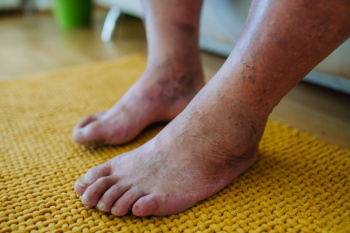
People with diabetes are more likely to develop foot issues due to poor circulation and reduced feeling in the feet. Cuts, blisters, or pressure points may go unnoticed and can quickly turn into serious wounds. Diagnosis begins with a thorough foot exam, including checking for sensation, skin changes, and blood flow. Special tests may be used to assess nerve function and evaluate the risk for ulcers or infection. Early detection is key to preventing complications, such as open sores or, in severe cases, tissue damage. Management focuses on daily foot care, proper footwear, and regular monitoring. If wounds are present, treatment may involve cleaning, dressing changes, and relieving pressure from the area. Advanced cases may require more intensive care. If you have diabetes and notice any changes in your feet, such as numbness, redness, or sores, it is suggested that you are under the care of a podiatrist who can help you to manage this serious condition.
Diabetic foot care is important in preventing foot ailments such as ulcers. If you are suffering from diabetes or have any other concerns about your feet, contact Josef Elouze, DPM from Elite Podiatry. Our doctor can provide the care you need to keep you pain-free and on your feet.
Diabetic Foot Care
Diabetes affects millions of people every year. The condition can damage blood vessels in many parts of the body, especially the feet. Because of this, taking care of your feet is essential if you have diabetes, and having a podiatrist help monitor your foot health is highly recommended.
The Importance of Caring for Your Feet
- Routinely inspect your feet for bruises or sores.
- Wear socks that fit your feet comfortably.
- Wear comfortable shoes that provide adequate support.
Patients with diabetes should have their doctor monitor their blood levels, as blood sugar levels play such a huge role in diabetic care. Monitoring these levels on a regular basis is highly advised.
It is always best to inform your healthcare professional of any concerns you may have regarding your feet, especially for diabetic patients. Early treatment and routine foot examinations are keys to maintaining proper health, especially because severe complications can arise if proper treatment is not applied.
If you have any questions, please feel free to contact our office located in (Holiday City) Toms River, NJ . We offer the newest diagnostic and treatment technologies for all your foot care needs.
Recognizing the Stages of Toenail Fungus
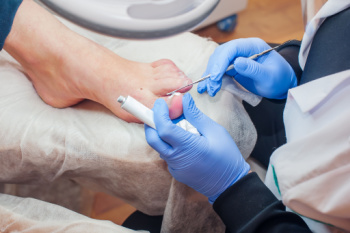
Toenail fungus progresses through early, moderate, and advanced stages. In the early stage, the nail may develop white or yellow spots and mild discoloration. The moderate stage brings thickening, increased discoloration, and brittleness. In the advanced stage, the nail may become deformed, separate from the nail bed, and emit an odor. Risk factors include walking barefoot in damp areas, wearing tight shoes, or having diabetes or poor circulation. Symptoms worsen over time and can cause pain or difficulty walking. A podiatrist can diagnose the severity of the infection and provide treatment, such as debridement, antifungal therapy, or laser treatment. If you have symptoms of toenail fungus, it is strongly suggested that you consult a podiatrist who can offer effective treatment solutions, which may include prescribed medication.
If left untreated, toenail fungus may spread to other toenails, skin, or even fingernails. If you suspect you have toenail fungus it is important to seek treatment right away. For more information about treatment, contact Josef Elouze, DPM of Elite Podiatry. Our doctor can provide the care you need to keep you pain-free and on your feet.
Symptoms
- Warped or oddly shaped nails
- Yellowish nails
- Loose/separated nail
- Buildup of bits and pieces of nail fragments under the nail
- Brittle, broken, thickened nail
Treatment
If self-care strategies and over-the-counter medications does not help your fungus, your podiatrist may give you a prescription drug instead. Even if you find relief from your toenail fungus symptoms, you may experience a repeat infection in the future.
Prevention
In order to prevent getting toenail fungus in the future, you should always make sure to wash your feet with soap and water. After washing, it is important to dry your feet thoroughly especially in between the toes. When trimming your toenails, be sure to trim straight across instead of in a rounded shape. It is crucial not to cover up discolored nails with nail polish because that will prevent your nail from being able to “breathe”.
In some cases, surgical procedure may be needed to remove the toenail fungus. Consult with your podiatrist about the best treatment options for your case of toenail fungus.
If you have any questions please contact our office located in (Holiday City) Toms River, NJ . We offer the newest diagnostic and treatment technologies for all your foot and ankle needs.
What Are Bunions?
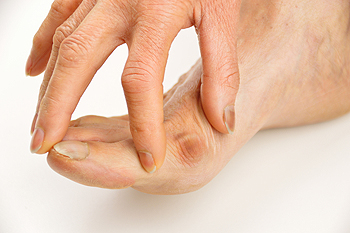
A bunion is a bony bump that forms at the base of the big toe, caused when the top of the toe shifts, pointing toward the other toes. This misalignment often results in a hard lump on the side of the foot, along with swelling, pain, and difficulty wearing shoes. Common causes include genetics, improper footwear, flat feet, or certain types of arthritis. Risk factors include wearing tight shoes and prolonged standing. A podiatrist can evaluate the severity of the bunion, provide relief through custom orthotics, recommend lifestyle changes, or suggest surgical options, if necessary. If you have developed a bunion, it is suggested that you seek professional care from a podiatrist to ease discomfort and prevent further joint damage.
If you are suffering from bunion pain, contact Josef Elouze, DPM of Elite Podiatry. Our doctor can provide the care you need to keep you pain-free and on your feet.
What Is a Bunion?
Bunions are painful bony bumps that usually develop on the inside of the foot at the joint of the big toe. As the deformity increases over time, it may become painful to walk and wear shoes. Women are more likely to exacerbate existing bunions since they often wear tight, narrow shoes that shift their toes together. Bunion pain can be relieved by wearing wider shoes with enough room for the toes.
Causes
- Genetics – some people inherit feet that are more prone to bunion development
- Inflammatory Conditions - rheumatoid arthritis and polio may cause bunion development
Symptoms
- Redness and inflammation
- Pain and tenderness
- Callus or corns on the bump
- Restricted motion in the big toe
In order to diagnose your bunion, your podiatrist may ask about your medical history, symptoms, and general health. Your doctor might also order an x-ray to take a closer look at your feet. Nonsurgical treatment options include orthotics, padding, icing, changes in footwear, and medication. If nonsurgical treatments don’t alleviate your bunion pain, surgery may be necessary.
If you have any questions, please feel free to contact our office located in (Holiday City) Toms River, NJ . We offer the newest diagnostic and treatment technologies for all your foot care needs.

